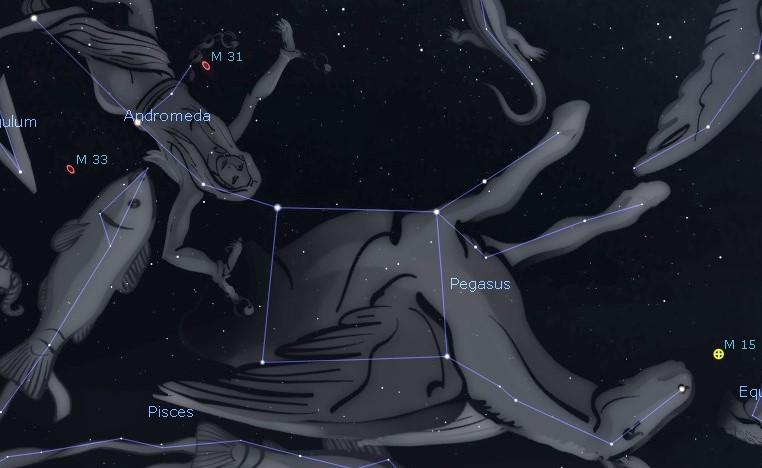
This Week’s Sky at a Glance, 2022 December 3 – December 10 ~ By Curt Nason
With the Great Square of Pegasus at its peak in the early evening it is a good time to visit the autumn constellations with binoculars. The flying horse soars upside down, and if you regard the two lines of stars in Andromeda as its hind legs it looks like a rocking horse. Well, to me it does. The horse’s neck stretches off the southwest corner of the square, and then it angles off to the snout. Extending a line from the head to the snout by about half that distance brings you to the globular cluster M15, looking like a fat star in binoculars or something snorted from the horse.
The opposite star of the square is Alpheratz at the head of Andromeda. The second star from there, along the brighter line of her body, is Mirach, which looks orange in binoculars. Moving to the star above it in the second line of Andromeda, and beyond to another star, puts you near M31, the Andromeda Galaxy. In a dark sky you can see it as a faint smudge with the naked eye and it is spectacular in binoculars. Going the opposite direction from Mirach, about halfway to the tip of Triangulum and a tad to the left, is M33. This face-on spiral galaxy is much tougher to see; you will need a transparent sky.
This Week in the Solar System
Saturday’s sunrise is at 7:45 am and sunset will occur at 4:42 pm, giving 8 hours, 57 minutes of daylight. Next Saturday the Sun will rise at 7:52 am and set at 4:41 pm, giving 8 hours, 49 minutes of daylight. We are into a two-week period, centred on December 10, when the sunset time varies by less than a minute, although daylight time decreases slowly until the solstice. The latest sunrise occurs during the first week of January.
The Moon is full just after midnight on the night of Wednesday/Thursday, around which time it passes in front of (occults) Mars for about 28 minutes. Less than two hours later, Mars is at opposition. Mars disappears at the lower left of the Moon and reappears at the bottom. This event is worth staying up to watch, especially with a scope or binoculars. Saturn is setting mid-evening so observe it early, while Jupiter is at its highest between 7 and 8 pm. On Friday evening binocular and telescope users can watch Jupiter’s moons Io and Europa disappear behind the planet at 8:29 and 11:43, respectively; and since you are up for the second one you can wait 20 minutes for Io to reappear from the planet’s shadow.
On Sunday evening at 8 pm, tune in to the Sunday Night Astronomy Show via the Facebook page or YouTube channel of Astronomy by the Bay.
Questions? Contact Curt Nason.
